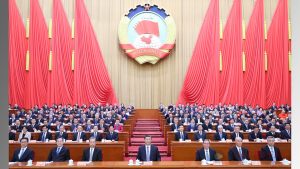
Moody’s Issues Downgrade Warning for China: Implications for Economy and Global Markets
Ratings agency Moody’s has recently issued a downgrade warning on China’s credit rating, marking the first change since 2017 when the country was downgraded by one notch to A1. The agency adjusted the ‘outlook’ on China’s A1 debt rating from “stable” to “negative,” citing concerns over the costs associated with bailing out local governments and state firms and managing the ongoing property crisis.
The Moody’s downgrade warning came just when nearly half of German companies operating in China had started taking measures to reduce the risk of doing business with Beijing largely due to growing geo-political tensions. This is according to a new survey by the German Chamber of Commerce in China which also states that firms are building supply chains that are independent of China, shifting some operations away from the country and growing markets elsewhere in Asia. The survey of 566 companies was conducted between 5 September and 6 October.
The latest change in China ratings is the first by Moody’s since downgrading it by one notch to A1 in 2017 when debt levels were rising. While Moody’s affirmed the A1 rating, noting that the economy still had a high shock-absorption capacity, it estimated that China’s economic growth would slow to 4.0% in 2024 and 2025, and average 3.8% from 2026 to 2030. It is assessed that China’s A1 rating is high enough in ‘investment-grade’ territory and a downgrade is unlikely to trigger forced selling by global funds. S&P and Fitch, the other major global rating agency, both rate China A+, the equivalent of Moody’s A1, and have stable outlooks. Moody’s main peer, S&P Global, said that its big concern was that “spillovers” from any worsening in the property crisis could push China’s gross domestic product growth “below 3%” next year.
China’s Finance Ministry called the Moddy’s decision disappointing, claiming the economy would rebound adding that property crisis and local government debt worries could be controlled. “Moody’s concerns about China’s economic growth prospects, fiscal sustainability and other aspects are unnecessary,” the ministry said. Reuters reported that blue-chip stocks slumped nearly 2% to near five-year lows on growth worries, with some traders also citing speculation about Moody’s statement before its release. China’s major state-owned banks, which had been supporting the yuan currency, stopped selling US dollars on the news of Moody’s downgrading.
The Chinese economy has struggled to mount a strong post-pandemic recovery as the deepening property crisis, local government debt concerns, slowing global growth and geopolitical tensions have curbed momentum. A flurry of policy support measures has proven to be only modestly beneficial, raising pressure on authorities to roll out more stimulus. In October 2023, China said it would issue 1 trillion yuan (US$ 139.84 billion) in sovereign bonds by the year-end to help revive economic activity, raising the 2023 budget deficit target to 3.8% of GDP from the original 3%. After years of over-investment, plummeting returns from land sales, and soaring costs to battle Covid, rating firms have been warning about the contingent liability risks of debt-laden Chinese municipalities.
Local government debt reached 92 trillion yuan (US$12.6 trillion), or 76% of China’s economic output in 2022, up from 62.2% in 2019, according to the latest data from the International Monetary Fund. Goldman Sachs data shows that capital outflows from China have also intensified, reaching US$ 75 billion in September, in the biggest monthly exodus since 2016. Moody’s said China needs to provide more support for debt-laden local governments and state firms which pose “broad downside risks to China’s fiscal, economic and institutional strength.” Moody’s also cited “increased risks related to structurally and persistently lower medium-term economic growth and the ongoing downsizing of the property sector.” The cost of insuring China’s sovereign debt against a default rose to its highest since mid-November, while the US-listed shares of heavyweight Chinese firms Alibaba and JD.com dropped 1% and 2%, respectively.
While the Moody’s ratings are notable, even more relevant are reports of German companies reducing their supply chain dependencies on China. This is because Germany has heavily invested in China. The latest Survey shows that 83 per cent of companies surveyed cited geo-political tensions as the main reason for taking measures to mitigate risks related to China business, while 45 per cent and 24 per cent respectively said it was related to China’s economic slowdown and greater focus on self-reliance. This shows that even foreign companies investing in China are concerned over the economic slowdown, something that Moody’s has voiced its views from time to time. According to the Survey, other countries are benefiting from this risk mitigation strategy, with 57.5 percent of companies surveyed saying they would be investing more in India, followed by 37.9 per cent for Vietnam, 30.1 per cent for Thailand, 23.3 per cent for Malaysia and 20.1 per cent for Singapore. This is good news for India and it waits to be seen in what timeline this de-risking towards India actually takes place.
The Survey comes five months after the government unveiled a strategy toward de-risking Germany’s economic relationship with China, its biggest trade partner and confirms what was reported by Reuters of German firms reducing their dependence on China. Other countries in the West are also promoting greater risk mitigation, amid growing concerns about China’s increasingly assertive attitude toward Taiwan and in the South China seas, as well as its tightening grip over its domestic economy. This in turn is beginning to have an impact on the world’s second-largest economy, with China recording its first-ever quarterly deficit in foreign direct investment in July-September. Clearly, China is in for a rough ride. In the first half of 2023, China grew by 5.5%, above the official target of 5%, but below the historical rate of growth. Persistence of deflation and youth unemployment compound growth woes. As in the case of Germany, China remains deeply embedded in the global supply chain and an economic slowdown in China will eventually have a ripple effect worldwide. Thus, domestic concerns apart, the world is watching very closely as China takes steps to tackle the challenges that face the world’s second largest economy.
















Comments